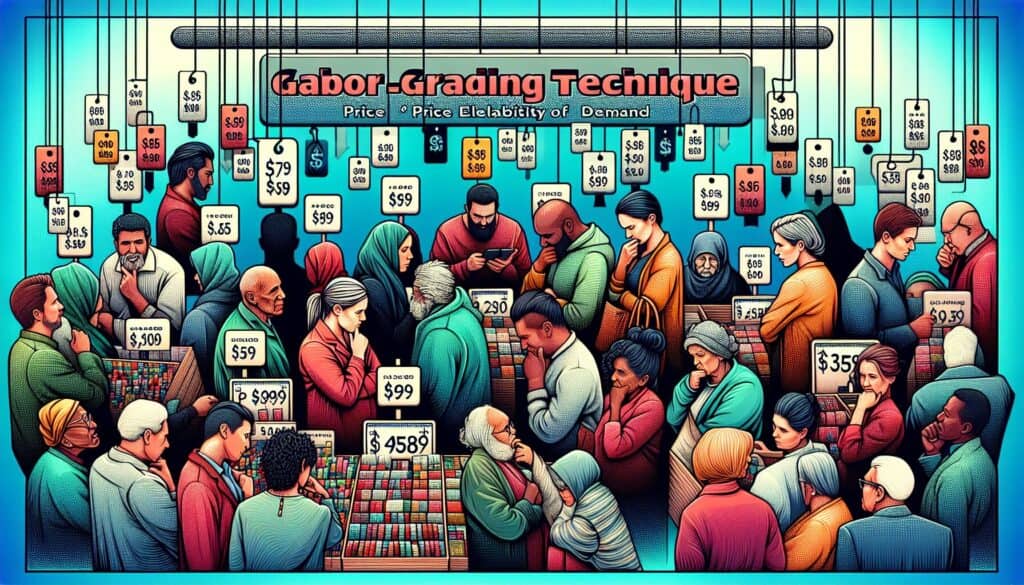Ermittlung der Preiselastizität der Nachfrage nach einem Produkt durch Befragung potenzieller Kunden nach ihrer Kaufwahrscheinlichkeit bei verschiedenen Preispunkten.
- Methodologien: Kunden & Marketing, Wirtschaft, Produktdesign
Gabor-Granger-Preismethode

Gabor-Granger-Preismethode
- Kundenerfahrung, Marktforschung, Produktmanagement, Produktpreisgestaltung
Zielsetzung:
Wie es verwendet wird:
- Den Befragten wird ein Produkt gezeigt und sie werden gefragt, ob sie es zu einem bestimmten Preis kaufen würden. Wenn ja, wird der Preis erhöht, wenn nein, wird er gesenkt (oder es wird eine zufällige Reihe von Preisen präsentiert). Dies wird für mehrere Preispunkte fortgesetzt, um eine Nachfragekurve zu erstellen.
Vorteile
- Misst direkt die Kaufbereitschaft bei bestimmten Preisen, hilft bei der Abschätzung des Umsatz- und Gewinnpotenzials bei verschiedenen Preisniveaus, relativ einfach in Umfragen umzusetzen.
Nachteile
- Hypothetische Kaufabsichten spiegeln möglicherweise nicht das tatsächliche Kaufverhalten wider und berücksichtigen nicht ausdrücklich die Aktionen der Wettbewerber oder Produktalternativen in der Befragung.
Kategorien:
- Kunden & Marketing, Wirtschaft
Am besten geeignet für:
- Schätzung der Nachfrage und des potenziellen Umsatzes für ein Produkt bei verschiedenen spezifischen Preispunkten.
The Gabor-Granger Pricing Technique is particularly effective in various stages of product development and marketing strategies across several industries including consumer goods, technology, and pharmaceuticals. This methodology can be especially beneficial during the product ideation and prototype testing phases, where understanding customer sentiment towards pricing can lead to informed design and marketing decisions. Key participants in this technique typically include product managers, market researchers, and pricing strategists, who together analyze customer responses to shape pricing strategies that align with perceived value. For instance, in the technology sector, companies launching new devices can employ this method to gauge how potential customers respond to different price points, allowing them to optimize pricing strategies right before launch. The healthcare industry often employs this technique in market research for new drugs or medical devices, where it is critical to understand pricing dynamics to ensure market access and reimbursement. The simplicity of this method allows organizations to gather quantifiable data efficiently through surveys and online platforms, which can be rapidly analyzed to generate demand curves, thus providing actionable insights that can adapt to different segments and preferences. By incorporating demographic factors or psychographic profiles, firms can segment responses, allowing for targeted pricing strategies that cater specifically to identified consumer bases, enhancing revenue potential while also refining product offerings based on real market data. This adaptability makes the Gabor-Granger approach a versatile tool for organizations navigating multiple market uncertainties.
Die wichtigsten Schritte dieser Methodik
- Show respondents a product along with an initial price point.
- Ask respondents if they would purchase the product at that price.
- If yes, increase the price in the next iteration; if no, decrease the price.
- Repeat this process for a series of price points to map demand.
- Analyze the responses to construct a demand curve based on willingness to buy.
Profi-Tipps
- Conduct sensitivity analysis to understand how variations in pricing affect demand elasticity, refining your price ranges accordingly.
- Incorporate psychographic factors into your survey design to capture deeper motivations and psychological pricing thresholds of different segments.
- Iterate on the pricing experiments by utilizing A/B testing methodologies to identify the most effective price points in real-time settings.
Verschiedene Methoden lesen und vergleichen, Wir empfehlen die
> Umfassendes Methoden-Repository <
zusammen mit den über 400 anderen Methoden.
Ihre Kommentare zu dieser Methodik oder zusätzliche Informationen sind willkommen auf der Kommentarbereich unten ↓ , sowie alle ingenieursbezogenen Ideen oder Links.
Historischer Kontext
1960
1980
1983
1990
1995
2000
2010
1950
1980
1980
1986
1994
1995
2000
(wenn das Datum nicht bekannt oder nicht relevant ist, z. B. "Strömungsmechanik", wird eine gerundete Schätzung des bemerkenswerten Erscheinens angegeben)














Verwandte Artikel
Monte-Carlo-Simulation
Modellbasiertes Testen
Modellprüfung
Forschung mit gemischten Methoden
Fehlervermeidung (Poka-Yoke)
Prüfung des Missionsprofils